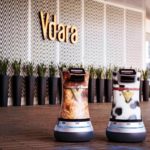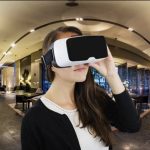
by Kelly | 10:28 pm | Blog
If there’s one buzzword for the hospitality industry this year, it’s “connectivity.” Hoteliers are helping travelers feel more connected than ever to their destination, from food and beverage programming to design to the brand itself.
Here are three ways hoteliers can give their guests a truly special and authentic experience in the coming year, and beyond.
Fresh & Beautiful F&B
Hotel restaurant and bars have long since evolved from the bland watering holes of yore. Today, they are gathering spots for the whole community, where guests can meet one another and locals alike, forging new friendships and memories.
Programming in the restaurants and bars can go a long way toward fostering those connections. Last year, Marriott’s Four Points brand kicked off its “Best Brews Around the World” program, which presents a local craft beer at each property. The beer is selected based on taste, popularity, quality, and proximity to the hotel, giving guests a taste of the destination that they might not be able to find anywhere else.
An exclusive offering can be just as appealing as a local one. Earlier this year, Halekulani, an independent hotel in Waikiki, Hawaii, launched its Legacy Collection of Spirits developed exclusively for the hotel by France’s Delamain Cognac and Kentucky’s Heaven Hill Bourbon. While cognac and bourbon are certainly not native to Hawaii, the chance to sample beverages not available anywhere else can attract a wider range of guests to the bar.
Connected Design
If guests are going to share the story of their trip on social media, they’ll need to be able to charge their phones wherever they are, and designers are finding lots of ways to add outlets and USB ports without affecting the aesthetic of a space. For example, Gjemeni’s mid-century-modern-inspired couch has four USB ports and two 110-volt sockets as part of the furniture, making it easy for guests to charge up while they socialize.
At the latest BDNY conference, Samuelson Furniture introduced the Smart chair, a traditional-looking armchair (think antique leather and high-back wings) with a charging port hidden on the inside of the arm. The chair is also bluetooth-enabled that transmits sound using directional sound resonation rather than a conventional speaker system, so guests can listen privately to music without headphones.
Legrand, a specialist in electrical and digital-building infrastructure, recently launched table umbrellas with solar panels on top and USB ports at the base. These devices let guests recharge their phones while relaxing outside — and, since the units are solar-powered, hotels do not need to install additional wiring to hook them up.
Of course, while technology may make it easier than ever for guests to connect with the destination when they travel, one-to-one connectivity is still the best kind. A hotel with plenty of sofas and chairs in its lobby can help forge new friendships among guests and locals alike.
The Growth of Soft Brands
By their very nature, it’s easier for an independent hotel to stay authentic and to reap all the benefits of those buzzwords. On the other hand, corporate brands offer powerful support that make a hotelier’s life much easier.
Soft brands are a happy medium, offering the support of a powerful corporation but much of the freedom of an independent. Nearly every major hotel company has them now, representing everything from luxury (such as Marriott’s aptly named Luxury Collection) on down (like Red Roof’s Red Collection, which focuses on the upscale-economy to midscale). Soft-branded hotels are gaining ground in a wide range of destinations, from beaches to city centers, making it easy for guests to have an authentic, local experience wherever they go.
By joining a soft brand, an independent hotel can get all the support it needs back-of-house, including participating in the company’s rewards program, managing billing and expenses, and achieving higher rankings in search engines. At the same time, the hotel must live up to certain standards in order to maintain the relationship, so incoming guests will know that while their accommodation will not look like any other, it will still be something that suits their tastes.
The soft brand relationship with a major hotel company is much less restrictive than a traditional franchise deal, and the fees the brand receives are much lower than what a franchisee pays. The growth of these soft brands across the spectrum is a good sign of their appeal for travelers and hoteliers alike.
Guests want to feel connected to their destination, and a hotel that provides an “only here” experience can count on repeat visits. Personalized and local experiences combined with a sense that the hotel actually cares about their well-being will keep them coming back and generate positive word of mouth.
How are you partnering with local businesses to create special experiences? How are you helping your guests stay connected? And what do you think are some other trends we’ll see in 2019?
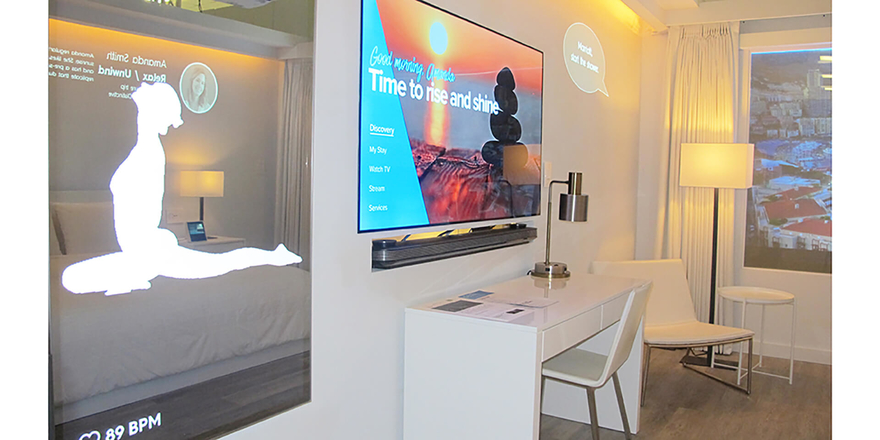
by Kelly | 8:45 pm | Blog
More than ever, hotel guests want personalized experiences when they travel. But in this age of super technology, the idea of a “personalized experience” is rapidly changing. While guests still value having a concierge create a unique itinerary for them or receiving a special in-room amenity, the shift is now towards being able to curate their own experiences – from viewing movies and listening to music from their own playlists, to customizing the scent of their guestroom. Here are some of the ways hotels are using next-gen technology to meet these new demands.
Connected Rooms
Last year, Marriott International partnered with Samsung and Legrand to launch a hotel room focused on the “Internet of Things.” (Think WIFI-connected coffeemakers that can be programmed through an app.) The IoT Guest Room Lab allows multiple systems, devices and applications to communicate with one another. For example, a guest could ask a virtual assistant for a wake-up alarm, to start a yoga routine on a full-length mirror, request additional housekeeping services, and start the shower at the desired temperature stored in their customer profile, either by talking to an IoT-connected device or using an app.
Not to be outdone, Hilton announced the Connected Room late last year, a unique high-tech guestroom that lets guests personalize and control every aspect of their stay from their mobile devices. Guests who stay at Connected Room-enabled properties will be able to use the Hilton Honors app to manage many things they would do manually in a room, from controlling the temperature and lighting to the TV and window coverings. Guests will also be able to stream content from their media accounts on the in-room TVs and pick up right where they left off at home.
Looking ahead, Hilton plans to have guests staying in Connected Rooms use voice commands to control their room or access their content, and to upload their own artwork and photos to automatically display in their room. Guests will also be able to set preferences in their Hilton Honors account profile to further customize their in-room experience to their individual preferences.
Hilton is also working on personalization through its Innovation Gallery, an incubator and experiential showcase for new product developments. Some of these developments include Nightingale, a noise-masking product; Somabar, a personal mixology solution; Meural, a customizable digital art display; and Pilot, a real-time translation solution.
Personalization isn’t limited to entertainment, of course: Israeli company Moodo makes aroma diffusers that let guests customize the scent of their rooms. Upon entering their rooms, guests can pick a pre-set fragrance combination suggested by the Moodo app or use the app to mix fragrances and create their own unique scents.
The Future of Personalization
While all of these high-tech options are certainly impressive and buzzworthy, they also raise a question of what hotel guests will come to expect in the future. One of the joys of travel is discovering new and exciting things, like songs on local radio stations and diving into surrounding the culture. While the ability to bring all the comforts of home on the road can be nice, some of the best parts of traveling involve stepping outside of comfort zones and disrupting established routines.
In short — will people want to get away from it all, only to take it all with them?
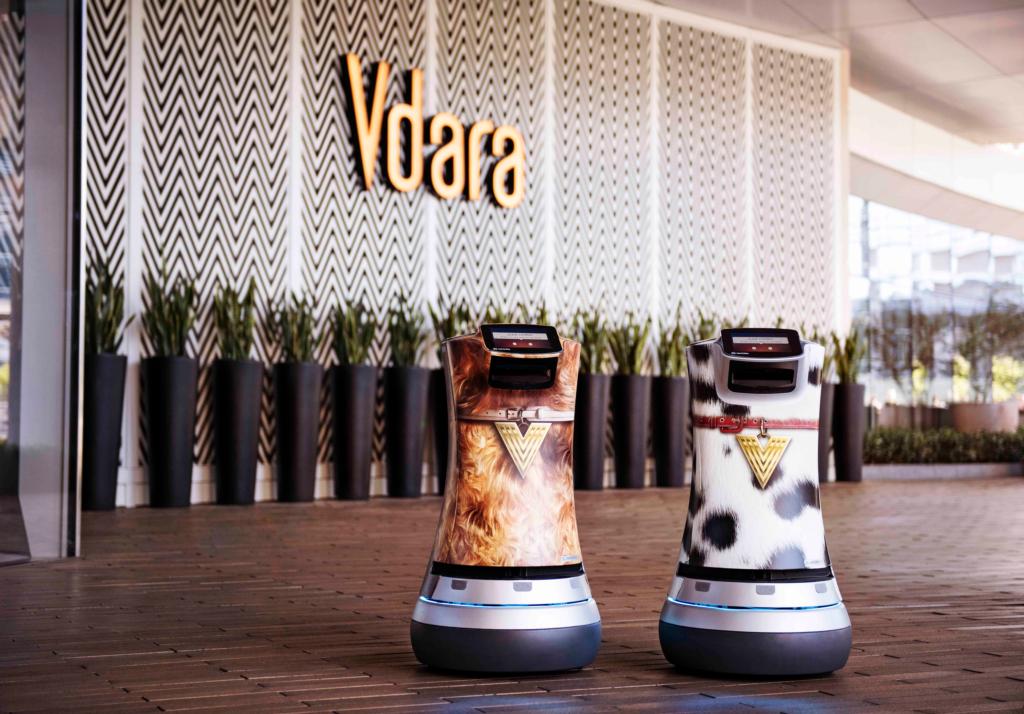
by Kelly | 11:29 pm | Blog
It wasn’t so long ago that people would call a restaurant for a reservation, or go to the video store to see what tapes were available, or waited on the sidewalk for an empty taxi to drive by. Just as technology has made all of these practices obsolete, new technology is automating many of the processes that used to take up the valuable time of both hotel guests and team members.
But while these new devices may be the wave of the future, hoteliers should think carefully before trying to cut down on costs by opting for automation. After all, technology is not only as good as the engineer who designs it, it’s also only as useful as the person who uses it.
Lobby Kiosks
Much like supermarkets with self-serve lanes, some hotels have started offering self-service kiosks in their lobbies, allowing guests to check in, check out, and search for information without having to speak to a front desk agent or a concierge. For the better part of a decade, designers and hoteliers alike have been adjusting lobbies to incorporate these devices into luxury and midscale hotels alike, leaving the front desk agents to deal with more complicated matters while the machines handle the simpler tasks.
The kiosks aren’t limited to checking in, of course. In the spring, Marriott’s Aloft brand – one that does not always include a full-service on-site restaurant – updated its Re:fuel by Aloft food & beverage program to include digital kiosks that let guests place breakfast orders with a few taps on a screen. Much as with the check-in kiosks, these machines take care of the basic parts of the transaction, but a team member can help with any special requests.
And while many kiosks are easy to use and self-explanatory, some guests may have issues with the machines that cause delays – the very challenge the devices were meant to avoid. The Park MGM Grand in Las Vegas uses such kiosks, and a search on TripAdvisor reveals numerous complaints about the devices and requests for help from the staff.
In-Room Devices
People who are accustomed to walking in their front door and saying, “Alexa, turn on the lights!” will be happy to find “smart” devices turning up in guestrooms. KEYPR, a technology company that focuses on cloud-based platforms for guests and hoteliers, is rolling out its system at the Silver Reef Casino in Ferndale, Washington. Guests will be able to use a custom-branded mobile app that includes a mobile key and in-room tablets to expedite their check-in and check-out, order room service, communicate directly with hotel staff (for example, texting the valet to get their car ready), and get messages from hotel staff whether on or off property. The hotel can also receive guest feedback through the app in real time for active service recovery.
Hotel G in San Francisco has Roxy devices in all 152 guestrooms, enabling guests to issue commands through the voice-activated speaker to get hotel information, order extra towels and amenities, arrange check out, and other typical hotel tasks. Roxy then relays the message to the front desk without anyone having to make a phone call. The device can also do things such as play music, provide weather information, and set a wake up alarm.
Some devices blend into the guestroom’s decor. Last year, KEYPR partnered with Mirror Image Hospitality to create Remi, a “smart mirror” that doubles as a TV and a virtual concierge platform. Guests can use the mirror to find information about the hotel and surrounding neighborhood, order room-service, make reservations at nearby restaurants or just watch TV. The Savvy SmartMirror is a similar product that comes in a voice-activated model which is useful when a guest’s hands are full. The SmartMirror is expected to debut next year in the Sinclair Hotel in Fort Worth, Texas.
And in June, Amazon launched Alexa for Hospitality, a new program that gives hotels an Amazon Echo to act as a voice-activated virtual concierge in each room. Amazon installed Alexa devices in some properties (including the Wynn Las Vegas) to find out how guests responded, and feedback surveys came back positive.
Following the trial, Marriott International is rolling out the Alexa program in several of its properties, with each brand getting devices customized to its demographic. (Westin hotels, which have a strong wellness focus, will get Alexa devices with meditation playlists, for example.)
But not everyone is enthusiastic about these devices, especially machines that are voice-activated and have to listen to whatever is going on in the room. While guests who like “virtual” services at home may appreciate the same in their hotel rooms, others may want the option to completely disconnect them and maintain their privacy.
Delivery Robots
Room-service robots have also gained ground in several years in hotels, going from cool quirk to useful tools.
Many of these robots double as butlers, delivering amenities and room service items, like the Relay robot from Savioke, which can be seen at the Luma Hotel Times Square in New York City. Savioke also built Fetch and Jett, two dog-themed robots at the Vdara Hotel & Spa in Las Vegas, who started serving snacks and drinks to guests over the summer.
LG, meanwhile, announced the CLOi (pronounced KLOH-ee) line of hospitality-focused robots earlier this year. Each robot has a different role to fill in a hotel’s setting: The serving robot delivers meals and drinks, while the porter robot delivers luggage to guestrooms and can also handle express check-in/check-out service and take care of payment.
Pros & Cons
All of this technology, from the robots to the kiosks to the in-room devices, can help hotels improve efficiency and give guests a unique experience, and it can also boost a hotel’s bottom line. According to a recent article in the Telegraph, citing research by the Economist Intelligence Unit, the cost of labor has more than doubled since 1990, but robot prices have nearly halved over the same period. This makes replacing employees with robots appealing from a bottom line point of view, and one study estimated that up to 65 percent of Las Vegas jobs could be replaced by machines. Mary Giuliano, Vdara’s general manager, told the Las Vegas Sun that guests enjoy the novelty of getting deliveries from Fetch and Jett, and that the robots free up time for the rest of the staff to focus on requests that require a higher level of service.
But not every guest wants to work with machines, and with privacy concerns on the rise, more people may opt to unplug their in-room Alexa and ask the concierge for advice directly. After all, an app can recommend a nearby show or restaurant but it often takes a concierge’s connections to secure hard-to-get seats. While automation may be the wave of the future, true hospitality depends on human interaction, and no machine can replicate that.

by Kelly | 11:10 pm | Blog
As more states ease laws on cannabis usage, hotels are finding new ways to incorporate the drug into their product offering, either catering to new demographics or offering new services for those eager to try something different and exciting.
According to a Gallup poll from late last year, more than 65 percent of Americans “support legalizing marijuana for both recreational and medicinal use.” So far, 31 states across the country now permit marijuana use in some form, even though the drug is still classified as “schedule 1,” meaning that it has a high potential for abuse. Even so, recreational use of cannabis is now legal in nine states as well as the District of Columbia, and businesses are jumping on the bandwagon.
After California legalized recreational use of marijuana earlier this year, the Desert Hot Springs Inn in the Coachella Valley began advertising itself as cannabis-friendly, allowing guests to smoke outdoors or using a vaporizer in the guestrooms. According to the Los Angeles Times, business improved by as much as 50%, while business at the 10-room Hicksville Pines Bud and Breakfast in Idyllwild increased by about 30% since its owner turned it into a “cannabis-centric property.”
But that uptick in business may not be enough for hotels across the state (and in other states where recreational use is legal) to permit guests to smoke up on property. Carl Winston, director of the school of hospitality and tourism management at San Diego State University, told the paper that there are significantly more problems with allowing marijuana on-site than there are benefits. For example, families may not want to stay in a smoke-friendly hotel, and a branded property that allows the use may cost sister hotels business from more conservative guests. And in terms of logistics, the cost of cleaning smoke from all of the textiles in a guestroom can be prohibitive. As such, many cannabis-friendly hotels may want to limit smoking to outdoor areas. For example, the 39-room Moment Hotel in West Hollywood only allows guests to smoke on the rooftop (this includes traditional tobacco products in addition to marijuana). Non-smokers, therefore, can breathe easy in the guestrooms and public areas.
If a hotel does not allow smoking on-site, it can still find other ways to cash in, especially with F&B. (After all, “edibles” are popular for a reason.) The Hollywood Roosevelt offers a mojito infused with cannabidiol (CBD), a non-intoxicating compound found in the cannabis plant, as well as three CBD-infused desserts. Peter Hansen, director of F&B for the hotel, told The New York Times that the CBD menu has proven popular, and guests have requested more options. The Thompson Seattle, meanwhile, has already offered several private dinners that include different strains of marijuana paired with food. More meals for the public are reportedly in the works.
Beyond edibles, CBD oil can be incorporated into spa treatments, like at the Spa Solage at Solage, Auberge Resorts Collection, in Napa Valley. The property offers a massage, facial and body scrub with CBD, promoting the treatments as helping to soothe insomnia, pain relief, anxiety and eczema. (It is worth noting that CBD, as a non-psychoactive compound, does not produce the same kind of “high” that THC, the psychoactive component of marijuana, does.)
Of course, there are pros and cons with integrating cannabis and marijuana into a hotel’s operations. If your state allows cannabis, will you incorporate it? We’d love to hear your comments!

by Kelly | 3:43 pm | Blog
Virtual reality has quickly gone from niche to ubiquitous in the travel sector, with professionals in every facet of the industry finding a purpose for the technology.
Two uses stand out for the hospitality industry — attracting guests to a hotel or destination, and keeping them engaged once they’re there. Hotels across the country have already invested in VR, and guests are learning to expect a high-tech experience both before and during their stays. Here are a few ways hotels are already taking advantage of virtual reality to get heads in beds.
Virtual Guests, Real Bookings
Virtual reality can give potential guests a taste of a hotel or destination pre-stay and help them book with confidence. If they can look around the space in advance, they’re less likely to face disappointments when they arrive.
Best Western Hotels & Resorts has the Best Western Virtual Reality Experience, a high-definition, 360-degree look into all of the company’s 2,200 North American properties. Each video gives guests an interactive tour of the hotel’s pool, lobby, fitness center and guest rooms, all in less than two minutes. Before making their reservations, potential guests can examine everything from the rooms to the types of chairs they will be sitting in. Earlier this year, Best Western was recognized by Fast Company magazine as one of the “Top 10 Most Innovative Companies” in the AR/VR category.
Last year, the Hilton Waikiki Beach made a virtual reality tour as part of its app and its website. Using their desktop computers, guests can go on a 360-degree tour and click on “hot spots” to learn more about anything they see. They can also put on VR headsets with their phones and virtually walk through the space.
It isn’t just hotels that are using VR to boost interest. Convention centers and destination marketing organizations have jumped on the bandwagon as well. The Palm Springs Convention Center launched an interactive 3D map and virtual tour through a partnership with Concept3D. Event planners and attendees can explore the whole 245,000 square feet facility, including the integrated 410-room Renaissance Hotel. All of the exhibit halls and outdoor spaces are displayed, and the map has a button so planners can request a proposal while they browse.
The Santa Clara CVB recently partnered with virtual travel platform Xplorit to create an aerial overview map of the city with integrated waypoints and 360-degree exploration of the city’s convention center, hotels, event spaces, and attractions. David Andre, vice president of marketing and communications at the Santa Clara CVB, told Meeting Planners International that VR was the “wave of the future” for promoting a destination or venue. Visitors spend an average of four minutes and 45 seconds on the website, Andre said, and that kind of immersion can easily becoming a booking.
On-Site Entertainment
Some hotels are incorporating VR into the onsite guest experience, keeping guests entertained on-property and making rainy days a little less dull.
In Las Vegas, the MGM Grand Hotel & Casino and Zero Latency launched a multiplayer free-roam VR experience inside the 2,000 square feet Level Up gaming lounge last year. The arena, “Virtual Reality Powered by Zero Latency,” allows up to eight people to play in an interactive digital world together, encouraging collaboration as opposed to isolation. Multiplayer games can include zombie apocalypse stories or physics-based puzzles that are good for families to play together.
“When it comes to playing games, and exploring new worlds in virtual reality, more people means more fun,” Zero Latency CEO Tim Ruse said when the project opened. “Technology can often be isolating but we are determined to continue to design games and experiences that bring people together for mind-blowing VR adventures and to forge real memories that can last a lifetime.”
Other hotels around the country have added VR game rooms to their public spaces. The Aventura Hotel, one of the Loews Hotel at the Universal Orlando, has a virtual reality game room where guests can play with motion tracking controllers for a unique family experience. In Arizona, the Trailblazers recreation center at the Fairmont Scottsdale Princess has a virtual roller coaster with specialized VR chairs.
The Viceroy Group’s Hotel Zetta in San Francisco introduced the VR “cube” installation in the lobby, designed by local upstart Exit Reality. The Exit Reality cube offers a broad range of top-tier content including Google Tilt Brush and Alazan Studio’s Holopoint, so guests can select a VR journey tailored to their interests. Aligning with Hotel Zetta’s focus on creativity, health, and mindfulness, Exit Reality has also curated a selection of custom experiences including Guided Meditation VR from Cubicle Ninjas. The hotel plans to expand the Exit Reality relationship in the future, adding the technology in guest rooms and offering exercise equipment that pairs with the VR system.
There are plenty of ways hotels can incorporate virtual reality into the guest experience, and new ones are coming online constantly. As travel planners and travelers alike become more tech-savvy, VR can help make sure that not only are their expectations met, but exceeded.

by Kelly | 4:13 pm | Blog
In spite of the impressive growth of loyalty programs and the stacks of membership cards we all have in our wallets, travelers don’t want to be just a number in a business’ computer. Hotel guests want to be recognized as individuals with unique tastes when they check in, and throughout their stay.
While it used to be hard to personalize the guest experience, the abundance of information that guests share both directly and indirectly with hotels has made it easier than ever to learn what a guest’s preferences are, and to personalize their stay to their tastes.
1. Use the property management system and loyalty program to keep notes on what guests like (or don’t like).
This is probably the easiest way to make sure that guests’ preferences are noted, and employees know what a guest likes or dislikes. Every member of the hotel team should pay attention to guest comments and record preferences in the customer profile. Did they say they prefer a certain brand of water over another? Write it down so that the staff knows to have a few bottles waiting in their room. It’s a small expense, but they’ll appreciate the gesture and will be much more likely to book a return visit.
2. Connect on social media
Positive social buzz is worth its weight in gold. When guests – or potential guests – tag the hotel, or even mention it in a public post on Facebook, Twitter, or Instagram, respond as quickly as possible and use the opportunity to find ways to make their stay special. Ask if they’re coming for a special occasion or if they are looking forward to something during the stay. Any information they share can be inspiration for a personalized touch. If a guest tweets that they’re craving cupcakes, bring one up to the room. Cost to the property? Maybe $5. Having your mastery of customer service shared over social media? Priceless.
3. Look up their hotel reviews and see what they’ve complained about in the past.
This may take a bit more time and effort, but it can make a big difference. Try to find hotel reviews on TripAdvisor, Yelp, and Google from an upcoming guest and see if they mention any unmet expectations or disappointments from stays at other properties. Another hotel’s loss can be your gain if you know in advance what a guest wants – or doesn’t.
4. Contact the guests before they arrive
For all the perks of the information age, an old-fashioned telephone call or personalized email can be the best way to connect with guests before their stay. Simply asking if the guest is in town for something special is an easy way to find out what they want during their stay, and to find simple ways to make it exceptional. Any property can have team members spend a few minutes each day reaching out and creating a connection. Guests will appreciate the extra time spent on making sure that their needs are met before they even arrive, and the hotel team can build up valuable loyalty.
5. Take advantage of technology in the hotel
Many hotel entertainment systems turn guestroom TVs into communication devices. Take advantage of this and have the TVs display a nice welcome message for when the guest checks in. Similarly, use TVs and monitors in public spaces to welcome VIPs or groups. Just a sign saying “Welcome!” and their names will be appreciated.
Hotels with Smart TVs should make it easy for guests to connect their own Netflix, Spotify, and other streaming service accounts to the in-room entertainment system. That way, they can watch their own content, and pick-up their binge-watching right where they left off. With the growth of digital concierge services, like the new Alexa devices that will be in Marriott hotels starting this summer, it will make it easier for guests to have their favorite playlists available with just a command.
Ultimately, personalizing a guest’s experience means that the guest never feels like mere revenue to a hotel, and when a guest feels valued, he or she is likely to not only come back, but to recommend the hotel to others.
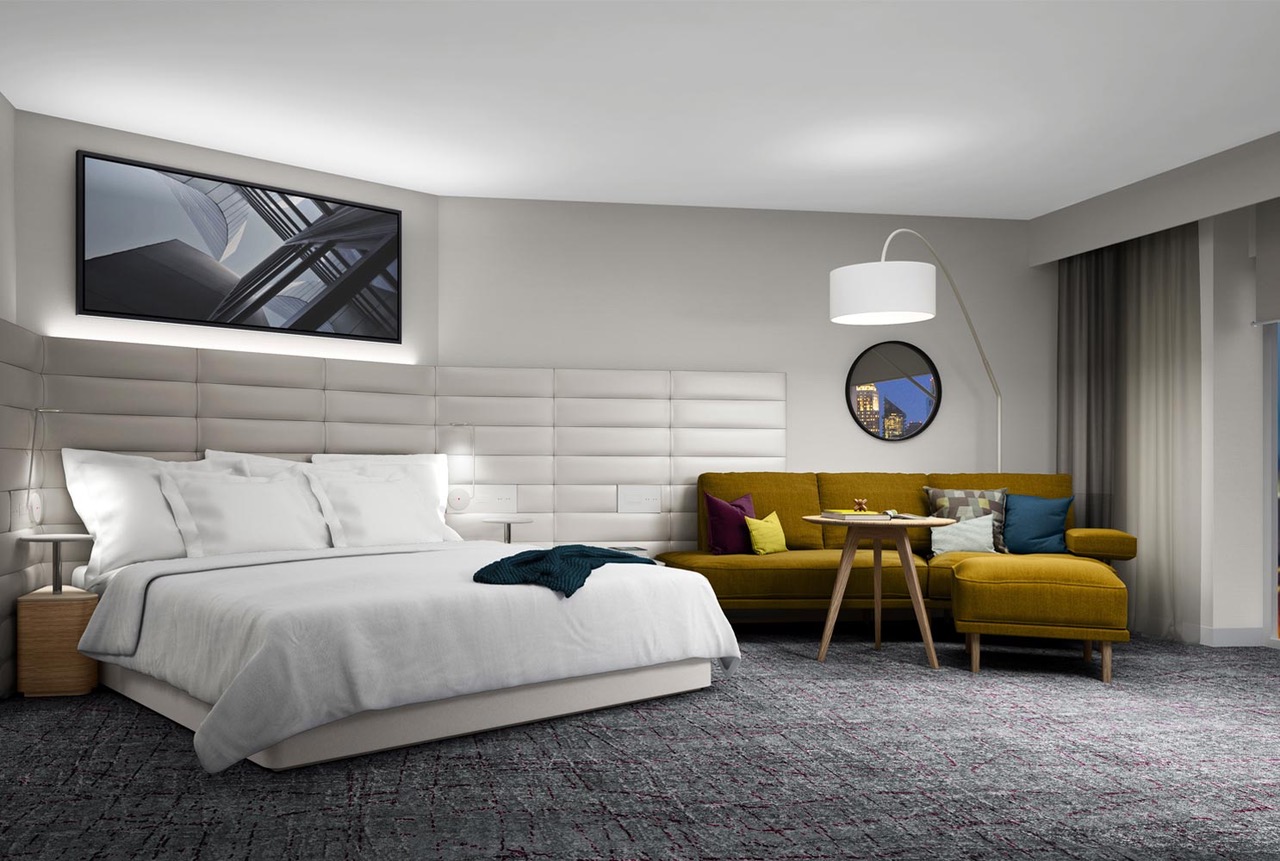
by Kelly | 12:44 am | Blog
Brand standards can make a hotel seem…well, standard. And with so many hotels flooding the market, it can be hard for travelers to tell one apart from the next, making it even more challenging to establish customer loyalty. But by carefully targeting specific types of guests and incorporating clever design and programing, a few hotel brands are standing out from the pack.
Business & Leisure
To attract business travelers, IHG’s Crowne Plaza brand has been updating its guestrooms and public spaces, adding touches that working professionals need. Hotels now have studio spaces off of the lobbies that guests and locals can rent by the hour for boardroom meetings, brainstorming sessions, and social functions (the rooms have touchpads for easy ordering of supplies and snacks as needed). The new WorkLife guestrooms have electrical outlets and USB ports everywhere so that guests can work wherever they’re most comfortable. Similarly, a moveable table makes it easy to work anywhere in the room, and a traditional desk is against the wall for those who like to do things the old-fashioned way.
Since Wyndham Hotel Group acquired Dolce Hotels & Resorts in 2015, the brand has focused on attracting business travelers with individual design and a localized F&B program. Dolce’s “Thoughtful Foods for Thoughtful Mind” program creates healthy and nourishing meals that are largely locally sourced and designed to keep guests (and event attendees) focused. The Nourishment Hubs, meanwhile, offer a unique twist on coffee breaks, with fresh, energizing snacks available in between meetings.
Hilton’s DoubleTree brand and warm chocolate chip cookies have become synonymous. For the DoubleTree in New York City’s Times Square, more than 1,000 TripAdvisor reviews mention those cookies as something guests both look forward to and appreciate. Combined with the brand’s reputation as one that welcomes pets (more than 120 DoubleTree hotels promote themselves as pet-friendly), the cookies help position the hotels as a popular choice for families.
Marriott’s Element by Westin, meanwhile, is focused on sustainability and wellness, starting from the ground up. Floors are made of recycled materials while the lighting and plumbing fixtures are energy-efficient. Guestrooms have paper recycling bins, recycled materials in carpets, and low VOC interior paints. For fitness-conscious guests, the brand has partnered with the Your Trainer app to help guests customize consistent workout routines wherever they stay. It also recently refreshed its “Bikes to Borrow” program through a partnership with Priority Bicycles, a New York City-based company that specializes in low maintenance bikes. All of the brand’s U.S. hotels have custom Element Priority Bicycles along with safety helmets available for guests to borrow free of charge.
Extended Stay
The extended-stay segment is one of the fastest growing in the industry, with brands like Choice’s Suburban to Hilton’s Homewood Suites offering a range from economy to upscale. There are any number of reasons why families and individual travelers are choosing these apartment-like hotels with kitchens, making these options all the more popular for guests and lucrative for hoteliers. Depending on what the guests want, the hotel can provide cocktail receptions, hot breakfasts, and laundry services – or more limited options for guests looking to save money.
But while extended-stay hotels are booming, there is a definite niche in the industry that has not yet been filled – upper-upscale and luxury spaces. Of course, there are soft brands in these spaces, and there are vacation rental services like Hilton Grand Vacations, Wyndham Vacation Ownership, and Marriott Vacation Club. While some properties in these collections may offer facilities for long-term stays, this option is not the same as a consistent brand offering the streamlined amenities from one property to the next.
When a guest who usually stays at a Four Seasons, a Ritz-Carlton, or even a Renaissance or a Westin needs a room for a week or more, the options become a bit more limited. Could this be the next niche a brand can fill? And if so, what will a luxury extended-stay brand look like?

by Kelly | 10:55 pm | Blog
Travelers want a real sense of place when they stay in a hotel, and designers are doing their part to make sure guests feel completely immersed in a destination from the moment they arrive. Here are just a few notable hotels from historic to ultra-modern (and modern twists on historic properties) that are evoking destination in their design.
Yotel
The airline-inspired Yotel brand already has a solid presence in airports and in urban hubs alike. The New York property, opened in 2011, was designed in collaboration by Rockwell Group and Softroom, and blends the airport aesthetic with a distinctly Gotham vibe, starting with the façade – pre-cast concrete surfacing lit with LEDs based on the brand’s logo. The lobby combines a “streamlined and futuristic” look with natural, classic touches. For example, a warm oak canopy covers the central feature of the space – the Yobot, a theatrically-lit robotic baggage drop-off machine. The inner workings of the robot are exposed to create a mechanical performance for the guests as it loads and stores their belongings.
Yotel will open its first conversion hotel later this year in San Francisco. The historic Grant Building was constructed in 1904 and is one of three buildings in the area to survive the city’s infamous 1906 earthquake. Now, it is under construction and is slated to become the 203-guestroom Yotel San Francisco this fall.
Las Alcobas
In Napa Valley, Las Alcobas, a member of Marriott’s Luxury Collection soft brand, opened in mid-2017. The main building in the complex, Acacia House, dates back to 1905 and has been fully restored with a wraparound porch. Encouraging guests to take advantage of the location, the property’s guestrooms have terraces with fireplaces, and 10 have outdoor soaking tubs. Guests can sit outside and look out over the adjacent vineyards, reportedly close enough to smell the grapes on the vines. (Bonus: Guests can get special access to the bottles, making this a great choice for wine lovers.)
The property’s interiors, designed by international firm Yabu Pushelberg, have custom furniture and spa-like bathrooms with soaking tubs and showers, stone-carved sinks, and marble throughout. In-room amenities include local wine and unique “alebrijes” — Mexican folk art sculptures of fantastical creatures (seen in the recent film Coco) that were handcrafted in Mexico City.
El Mangroove
In Costa Rica, El Mangroove is a boutique 85-suite hotel that joined Marriott’s Autograph Collection soft brand in 2016. The resort’s design incorporates natural elements from the country – think local wood and water features, along with bamboo, stone, and natural furnishings that merge all indoor and outdoor spaces. The hotel has a fitness center with outdoor “wild-fit” areas and multi-functional exercise decks.
Hotel Indigo
The 350-room Hotel Indigo Los Angeles Downtown opened last year as a sister property to the larger InterContinental Los Angeles Downtown. Although it is a chain, each property can create its own story and theme. The Los Angeles property celebrates the life and career of Anna May Wong, Hollywood’s first Chinese-American movie star. Much of the artwork at the hotel evokes Wong and 1920s Hollywood. For example, the design on the carpet looks like camera flashes, and old photos are recreated in large scale on the walls. A video installation celebrates the Fiesta de los Flores, a flower-themed parade that used to be held in the area. Other floral artwork can be seen throughout the public spaces, complementing the historic Hollywood elements.
Mayfair Hotel
In downtown Los Angeles, the historic Mayfair Hotel emerged from a major renovation last year that brought the property back to its historic heyday. At nearly a century old, the hotel now evokes its heritage with old maps of the city covering one wall of most guestrooms and preserved historic elements in the public spaces. Designer Gulla Jonsdottir recreated the look of the hotel’s original ceiling with a new chandelier that casts upwards shadows with the original pattern. Most of the lobby’s custom-made furniture is a mix of antique and new.
Whether a hotel is historic or new, there are plenty of ways to evoke a destination in its design, from small touches to the whole architecture. It’s never too late to update a property’s look with some local inspiration, and even the smallest details can have a big impact on a guest’s experie
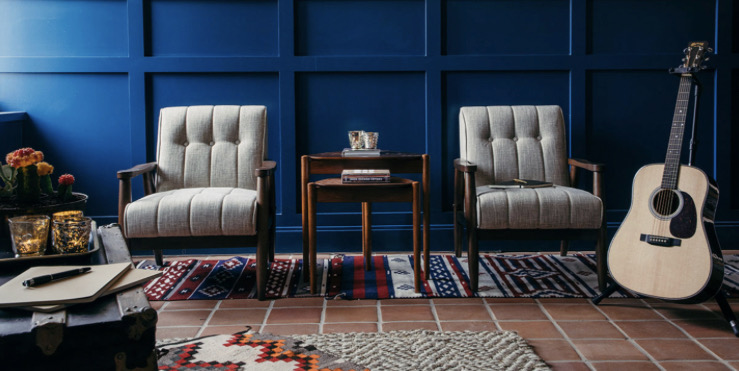
by Kelly | 10:14 pm | Blog
Today’s travelers aren’t interested in cookie-cutter hotels. When they’re on the road, they want to feel like they are truly in a destination. Whether or not a hotel must adhere to brand standards or a certain budget, there are plenty of ways to bring a bit of the community into the space. Here are a few examples of what different hotels, both branded and independent, have been doing to make sure guests get a true sense of place.
The Living Stage
Red Lion Hotels’ upscale boutique brand Hotel RL has a dedicated platform for local artists. The “Living Stage” hosts a wide range of performances and interactive activities – from public speakers to musical performances to hands-on demonstrations. In March alone, Hotel Rl Baltimore Inner Harbor hosted a painting event with local visual artist Kris Diggs, Hotel RL Spokane at the Park hosted local writer Kate Poitevin, and the Olyimprov team performed at the Hotel RL Olympia. Because there’s always something different on any given day, guests and locals alike can come back and see something new and interesting.
Cultural Education
Classes are a great way for guests to learn more about the area, especially if many of them are international. On Mexico’s Yucatan peninsula, the wellness-focused Chablé Resort & Spa hosts classes on Mayan cuisine where participants make their own tortillas from fresh corn as well as peel and roast local chilies to make salsas. The resort’s Temazcal Ceremony recreates the traditional Mesoamerican version of a sweat lodge, part of a curative ceremony thought to purify the body after exertion, to heal the sick, and improve general health. The ceremony is guided by a local shaman.
Rooms for Writers
In Miami, The Betsy-South Beach emphasizes arts and culture in its programing, displaying work from local and global artists, hosting musicians, and bringing in thought leaders to talk about their expertise with guests. Thanks to a dedicated “Writers’ Room” that offers residencies to up-and-coming wordsmiths, the hotel also hosts poetry readings and meet-and-greets with the writers.
In Nashville, guests can get a taste of the city’s powerful music scene in the Hutton Hotel’s two “Writers’ Rooms,” where guests can play custom Martin guitars in the vocal booth. Artist-selected custom Gibson guitars and an antique writer’s desk invite guests to compose their own songs and write their own lyrics. Each room has modern and retro-style gear ranging from premium tube amps to handcrafted microphones. A “Pic Jar” encourages guest artists to snap a photo and leave it behind for the next aspiring musician to find.
Visual Art
Technology is making it easier for hotels to display local artwork. San Francisco-based Daylighted partners with artists, galleries, museums, and other associations to bring artwork to large and small screens alike, anywhere in the world. Hotels can display a curated collection of work from local and global artists on large screens in public spaces or in guestrooms, rotating the images as needed. Best of all, guests can easily purchase any pieces that they like with a few clicks. Daylighted has curated artwork for Marriott, Sofitel, and Hyatt properties, among others.
There are also low-tech ways for hotels to promote local artists. The upcoming boutique Sophy Hyde Park in Chicago has partnered with Hyde Park Academy High School to install an exterior mural as an outdoor art gallery in front of the under-construction building. The mural will serve as a fixed exhibition wall that will remain on view throughout the construction phase, displaying 60 original works of art by the young art students.
What You Can Do
While not every hotel can have a full theater or be attached to a museum, these examples can help any property give its guests a taste of local flavor. A hotel lobby can easily become an art gallery for local talent (contact nearby art schools to see what’s available nearby), and rotating artwork makes sure that repeat guests always have something new to see. A digital display can be an eye-catching way to show off the work of numerous artists at once, and to help connect the artists with potential buyers.
Even hotels with small footprints can host musical acts for guests and locals. Lobbies (and lobby bars) are a perfect venue for area musicians to entertain guests while they socialize in the evening. In good weather, set up a space outside and encourage guests to linger by a fire pit and listen to the music (and, of course, order a few drinks). The bands will value the opportunity to build up a fan base, the guests will appreciate the music, and everyone will leave happy. Best of all, the guests will have had an experience that they could not have had anywhere else.












